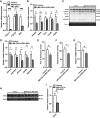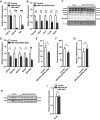Adult skeletal muscle peroxisome proliferator-activated receptor γ -related coactivator 1 is involved in maintaining mitochondrial content
- PMID: 36717166
- PMCID: PMC10026983
- DOI: 10.1152/ajpregu.00241.2022
Adult skeletal muscle peroxisome proliferator-activated receptor γ -related coactivator 1 is involved in maintaining mitochondrial content
Abstract
The peroxisome proliferator-activated receptor γ coactivator-1 (PGC-1) family of transcriptional coactivators are regulators of mitochondrial oxidative capacity and content in skeletal muscle. Many of these conclusions are based primarily on gain-of-function studies using muscle-specific overexpression of PGC1s. We have previously reported that genetic deletion of both PGC-1α and PGC-1β in adult skeletal muscle resulted in a significant reduction in oxidative capacity with no effect on mitochondrial content. However, the contribution of PGC-1-related coactivator (PRC), the third PGC-1 family member, in regulating skeletal muscle mitochondria is unknown. Therefore, we generated an inducible skeletal muscle-specific PRC knockout mouse (iMS-PRC-KO) to assess the contribution of PRC in skeletal muscle mitochondrial function. We measured mRNA expression of electron transport chain (ETC) subunits as well as markers of mitochondrial content in the iMS-PRC-KO animals and observed an increase in ETC gene expression and mitochondrial content. Furthermore, the increase in ETC gene expression and mitochondrial content was associated with increased expression of PGC-1α and PGC-1β. We therefore generated an adult-inducible PGC-1 knockout mouse in which all PGC-1 family members are deleted (iMS-PGC-1TKO). The iMS-PGC-1TKO animals exhibited a reduction in ETC mRNA expression and mitochondrial content. These data suggest that in the absence of PRC alone, compensation occurs by increasing PGC-1α and PGC-1β to maintain mitochondrial content. Moreover, the removal of all three PGC-1s in skeletal muscle results in a reduction in both ETC mRNA expression and mitochondrial content. Taken together, these results suggest that PRC plays a role in maintaining baseline mitochondrial content in skeletal muscle.
Keywords: PGC-1-related coactivator; mitochondria; mitochondrial biogenesis; skeletal muscle.
Conflict of interest statement
No conflicts of interest, financial or otherwise, are declared by the authors.
Figures




References
Publication types
MeSH terms
Substances
Associated data
Grants and funding
LinkOut - more resources
Full Text Sources
Medical
Molecular Biology Databases
Research Materials

